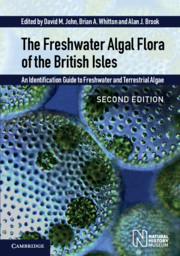 The Freshwater Algal Flora of the British Isles
The Freshwater Algal Flora of the British Isles Book contents
- Frontmatter
- Contents
- The online material (formerly provided in DVD format)
- List of Contributors
- Foreword
- Preface
- Acknowledgements
- Introduction
- Distribution and Ecology
- History of Freshwater Algal Studies in the British Isles
- Field Methods
- Laboratory Methods
- Water Framework Directive
- Cultures of British Freshwater Algae
- Classification
- Key to phyla
- Cyanobacteria (Cyanophyta)
- Phylum Rhodophyta (Red Algae)
- Phylum Euglenophyta (Euglenoids)
- Phylum Cryptophyta (Cryptomonads)
- Phylum Dinophyta (Dinoflagellates)
- Phylum Raphidophyta
- Phylum Haptophyta (Prymnesiophyta)
- Phylum Chrysophyta (Golden Algae)
- Phylum Xanthophyta (Tribophyta) (Yellow-Green Algae)
- Phylum Eustigmatophyta
- Phylum Bacillariophyta (Diatoms)
- Phylum Phaeophyta (Brown Algae)
- Primitive Green Algae (‘PRASINOPHYTA’)
- Phylum Chlorophyta (Green Algae)
- Phylum Glaucophyta
- Glossary
- Standard Form of Authors of Algal Names
- Sources of Illustrations or Material
- References
- Taxonomic Index
- Subject Index
- Plate Saction
- Miscellaneous Endmatter
- Miscellaneous Endmatter
Phylum Eustigmatophyta
Published online by Cambridge University Press: 12 January 2024
- Frontmatter
- Contents
- The online material (formerly provided in DVD format)
- List of Contributors
- Foreword
- Preface
- Acknowledgements
- Introduction
- Distribution and Ecology
- History of Freshwater Algal Studies in the British Isles
- Field Methods
- Laboratory Methods
- Water Framework Directive
- Cultures of British Freshwater Algae
- Classification
- Key to phyla
- Cyanobacteria (Cyanophyta)
- Phylum Rhodophyta (Red Algae)
- Phylum Euglenophyta (Euglenoids)
- Phylum Cryptophyta (Cryptomonads)
- Phylum Dinophyta (Dinoflagellates)
- Phylum Raphidophyta
- Phylum Haptophyta (Prymnesiophyta)
- Phylum Chrysophyta (Golden Algae)
- Phylum Xanthophyta (Tribophyta) (Yellow-Green Algae)
- Phylum Eustigmatophyta
- Phylum Bacillariophyta (Diatoms)
- Phylum Phaeophyta (Brown Algae)
- Primitive Green Algae (‘PRASINOPHYTA’)
- Phylum Chlorophyta (Green Algae)
- Phylum Glaucophyta
- Glossary
- Standard Form of Authors of Algal Names
- Sources of Illustrations or Material
- References
- Taxonomic Index
- Subject Index
- Plate Saction
- Miscellaneous Endmatter
- Miscellaneous Endmatter
Summary
The Eustigmatophytes are small, single-celled coccoidal algae, the term ‘eustigma’ referring to a conspicuous orange-red eyespot that is possessed only by flagellated forms. In such forms the flagella are inserted near the cell apex, and on the anteriorly directed flagellum are two rows of tripartite hairs (not visible with the light microscope). A second flagellum, if present, is usually very short, posteriorly directed and smooth. The eyespot has a unique structure and is at the anterior end of the cell where it is not associated with the chloroplast. It consists of a number of carotenoid-containing globules above which lies the basal expansion of the long flagellum. The one or more yellow-green chloroplasts contain chlorophyll a and violaxanthin is the principal accessory pigment. The pyrenoid characteristically projects on a short stalk from the inner side of the chloroplast and is surrounded by flat plates of an unknown food storage material; pyrenoids are not present in all eustigmatophycean algae and are never present in zoospores. Another unusual feature is the presence of a red-pigmented body whose role is unknown. Reproduction is by the formation of 2 or 4 autospores or zoospores.
The phylum was created to include a number of algae previously classified in the Xanthophyta (Hibberd, 1980; Santos, 1996). It currently consists of a single order (Eustigmatales) divided into 4 families containing about 7 genera and 15 species; most are freshwater or soil-dwelling, although there are some marine representatives. One unusual genus (Corvomyenia) is a symbiont within a freshwater sponge. Other eustigmatophytes reported from the British Isles are only known from brackish waters (e.g. Nannochloris ocelata Droop).
The eustigmatophytes are commonly mistaken for green algae when examined with the light microscope. Features useful for distinguishing flagellated forms are the separation of the prominent eyespot from the chloroplast and, in the case of coccoidal cells, the presence of a stalked pyrenoid, although this is not always very evident. The carbohydrate storage material, which does not stain with Lugol’s solution or iodine, is another useful distinguishing feature. Otherwise the identification of some genera and subgeneric taxa requires examination by transmission electron microscopy.
- Type
- Chapter
- Information
- The Freshwater Algal Flora of the British IslesAn Identification Guide to Freshwater and Terrestrial Algae, pp. 346 - 347Publisher: Cambridge University PressPrint publication year: 2021


